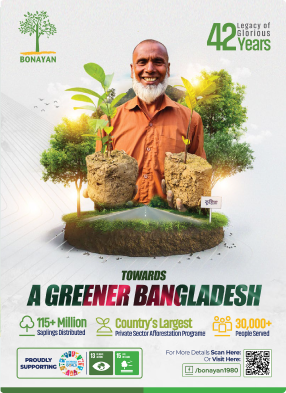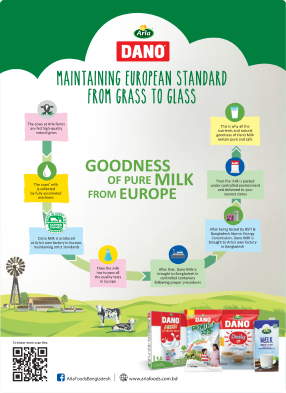- info@ficci.org.bd
- |
- +880248814801, +880248814802
- Contact Us
- |
- Become a Member
- |
- |
- |
- |
- |
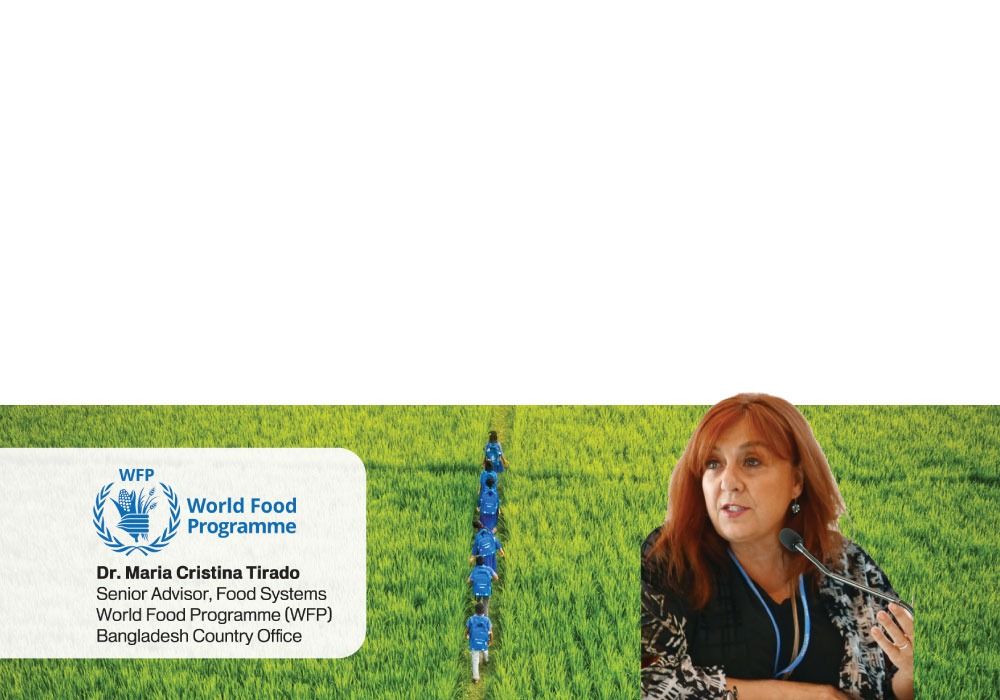
Floating Gardens is an ancestral agriculture practice that has been used for centuries in the wetlands of the Southern flood plains in Bangladesh (in Barishal, Goplaganj, and Pirojpur districts). This traditional practice has been revived as an innovation for climate adaptation for livelihoods and food security in flood-prone and coastal regions. The UN's Food and Agricultural Organisation declared the floating gardens in Bangladesh to be a Globally Important Agricultural Heritage System (GIAHS). These are landscapes that combine agricultural biodiversity, resilient ecosystems and cultural heritage. This innovation is considered by Governmental and non-governmental groups as a pillar in climate- resilient development, for food security and to reduce poverty in flood-prone areas in Bangladesh.
This is one of the many innovations that the World Food Programme (WFP) considers spearheading in Bangladesh as an adaptation to the impacts of climate change (rising waters, storms, erosion) on the livelihoods and food security of poor and landless communities in areas with extended flooding and waterlogged conditions.
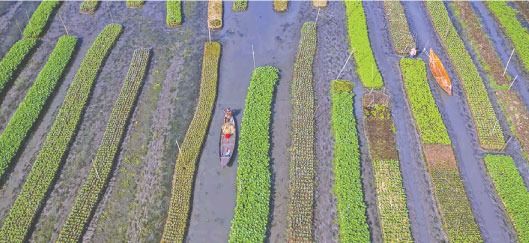
Hydroponic farming: innovative climate adaptation based on Indigenous and local knowledge
This traditional hydroponic practice consists in growing vegetables, spices and other crops in floating beds made from water hyacinth (Eichhornia crassipes), aquatic weeds, and other organic materials.
Floating gardens can adjust to rising and falling water levels and have been an effective adaptation option for food security and livelihoods in flooding environments for centuries. Floating farming is based on Indigenous and local knowledge, and it is called Dhap or Baira, by the communities in the Southern flood plains in Bangladesh. Floating farming can be useful in wetlands during periodical floods and in recovering livelihoods after extreme events and floods. Floating gardens and the landscapes they create, bring social, economic, agroecological, and environmental benefits to local populations.
Socio-economic relevance
Floating gardens that are easily accessible, cost-effective, reliable, environmentally friendly, and provide major livelihood options for about 60-90% of the locals in the Southern flood plains in Bangladesh. As sea levels rise and agricultural land is lost, floating gardens offer additional space by transforming the flooded areas into productive ones. Floating agriculture has expanded arable land by 40% for cultivating crops such as spinach, okra, turmeric, potatoes, cucumbers, gourds, and amaranth in flood-prone areas (Barois et al., 2024). The productivity of floating agriculture systems is estimated to be ten times higher than that of similar-sized land-based agriculture. Farmers who have adopted floating garden practices are enjoying a better life economically, than those in other flood-affected areas who have not yet adopted this practice. Floating agriculture is labour-intensive and encourages the engagement small farmers, resulting in a 1.80 times higher benefit-cost ratio compared to traditional land-based agriculture (Bala et al., 2020). These systems employ men and women, improving gender balance (MOA, 2011). Socio-economic benefits of the floating gardens include the increase in household income from the organic production in the floating gardens; employment in wetlands such as 'Haors'; promotion of local practices and conservation of indigenous knowledge and cultural heritage. The use of floating agriculture as an adaptive measure also provides direct economic benefits. Vegetables and spices produced on the floating gardens are fully organic, and these products receive special attention from local buyers and consumers.
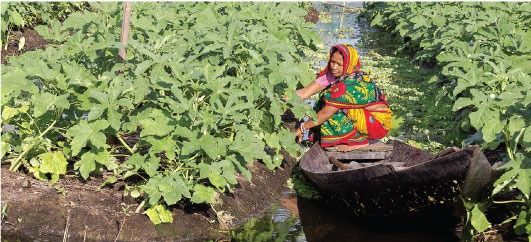
Photo credit: Badal Sarker for the Department of Agricultural Extension, Bangladesh
Agro-diversity and food security
Floating garden agriculture systems allow the agro-diverse production of vegetables and crops almost all year round to meet the food security and nutrition of the communities living in the wetlands and contributing to communities' health. In summer, during the monsoon season, vegetables such as okra, ribbed gourd, cucumber, brinjal, Indian spinach, and amaranths, are grown in floating gardens. Major groups of crop spices include turmeric and ginger. In winter, with the recession of flood water, the floating beds serve as ecological compost for the land agriculture of turnip, cabbage, cauliflower, tomato, and red amaranths. The land with water is used to produce fish in the open water, and crops on the floating beds, contributing to agro-biodiversity, sustainable use of natural resources and dietary diversity. In these regions, ribbed gourd is usually intercropped with Okura. After harvesting Okura, vines of ribbed gourd coil around the stem of okra plants to grow. In addition to the floating gardens, rice cultivation in wetlands is the dominant crop in Bangladesh. The production of Boro rice (November-May) is the most popular in this region to minimize flooding risks. Fishing is the second source of income in this region. Flood plains provide a favourable environment for growing and feeding larvae, hatchlings, and fry, and for brood stock reproduction. A variety of fish, prawns, mussels, and snails are critical sources of protein for local communities. Snails are also harvested to feed aqua-cultured freshwater giant prawns. Mussel shells are used to make lime to be mixed with betel leaves and nuts to produce fertile hummus. Several species of freshwater mussels bear pink pearls.
Climate resilient- adaptive innovation
In recent years, floating gardens have been revived as an innovative climate adaptation option in flood-prone areas. The Bangladeshi region is in plains of silt formed by the Ganges River and its tributaries, which often change their courses. When the monsoon blows and snow melts in the Himalayan peaks, the result is flooding covering large areas of the country for up to eight months of the year. Even if the floodwaters recede temporarily, the soil has reached a degree of saturation that makes it unsuitable for agriculture, which represents one of the most important sectors contributing to GDP.
Climate variability is changing the precipitation and hydrogeological patterns in deltaic countries, such as Bangladesh and this is leading to extended flooding and waterlogged conditions more frequently. Since May 2024, Bangladesh has been severely affected by a series of climate-related disasters, including Cyclone Remal in May, flash floods in the Haor Region in June, riverine floods in the Jamuna Basin in July, and unprecedented flooding in the eastern regions in August. The most recent floods were in Chattogram. Most of the current 1.6 million people facing high acute Food Insecurity in IPC Phase 4 (Emergency), are in the Chattogram, Rangpur, Khulna, and Sylhet divisions (IPC, 2024).
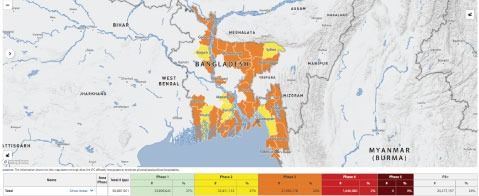
Map shows Acute Food Insecurity Projection Update in Bangladesh from the last quarter of 2024. For this analysis, the IPC Technical Working Group guided the IPC Ontegrated Food Security Phase Classification update) process, supported by WFP Research Analysis and Monitoring team and others (FAO MEAL Unit and IPC Global Support Unit)
Ecological and Sustainable
Floating agriculture is an environmentally friendly practice to utilise the natural resources of wetlands to grow vegetables and other crops almost all year round. Floating farming does not need any additional water, nutrients, or chemical fertilisers, and the beds can be recycled as organic fertiliser in the newly prepared floating bed and, also in the agricul tural lands. This is economical and environmentally friendly. Since nitrogen, potassium and phosphorus are abundant in the floating beds there is basically no need of fertiliser inputs and almost no pesticides are applied. Women's engagement in agricultural practices ensures the sustainability of the system. A good water environment is sustainably maintained through adequate control of water hyacinth, water purification and low output (return) of eutrophication nutrient
Scaling-up Capacity Building and R&D
More than 6,000 subsistence farmers have adopted Floating Agriculture practices across the southwest, this may prove crucial as climate change sends sea levels higher and makes the monsoons more erratic. Research Institutes continue their studies to increase the efficiency of this approach, which research ranks as the best food production for 90% of the population of humid areas. The Ministry of Agriculture in Bangladesh is working to expand this innovation It has trained more than 500 farmers and implemented the project in more than 50 locations. Its goal was to meet the needs of 12,000 families, with a focus on supporting marginalized women and providing them with the necessary expertise to apply this approach and support their families. These farms are not a radical solution, they cannot withstand the most extreme weather events, especially if the effects of climate change continue without effective intervention Research and Development (R&D) intiatives aim to improve the production system and transfer the system of production to similar wetland ecosystems. Bangladesh Agricultural Research Institute and the Department of Agriculture Extension have research projects for further development of the system.
Globally Important Agricultural Heritage System (GIAHS) opportunities
Floating garden agricultural practices have been spreading within Bangladesh due to the efforts of NGOs and govern- ments. Recognition and designation of the floating garden as Globally Important Agricultural Heritage System (GIAHS), public and private sector initiatives in the improvement of the areas of technicality of the production system, marketing and value addition of the product may be strengthened. These efforts would improve the production of quality organic vegetables, fruits and spices and fetch profit commensurate to the desire of the practitioners. The society would find more opportunities to invest in asset development, production and marketing, value addition and tourism, Bangladesh is establishing a significant niche in the global spice trade, heralding a new era in the spice export industry. This offers a space for the organic production in GIAHS Floating Garden of spices such as Turmeric, Ginger, and Red Chile Organic GIHS spices from Bangladesh can be exported to Saudi Arabia and enter in new markets in other Gulf countries, USA, EC, among others
WFP in Bangladesh
Over the past 50 years, WFP has supported more than 155 million people through both emergency response and longer-term resilience building. While continuing to provide humanitarian assistance, WFP has shifted towards a more advisory role, assisting the Government in efforts to achieve Sustainable Development Goal 2 on ending hunger.
REFERENCES:
Boris, ZO, Hasan MM, Ahmed, F, Recario, SR, Islam, MA, Kaca, MMH, Shaheen N, & Dengerink J. (2004) An Overview of the Bangladesh Food System: Outcomes, Drivers & Activities Foresight4Food Oxford
Bas H. Ghosh AK. Kazal MMH. Raman MS. Sultana, M. and Sujan, MHK 2020 Floating gardening in Bangladesh a sustainable income generating activity in wetland areas. Int. J. Agril Resinnox Tech 1000 87-93 https:/doi.org/10.332910114809 tegrated Press Classification 2024, Bangladesh Integrated Phase Classification IPC Acute Food Insecurity Projection Update October-December 2004
Ministry of Agriculture Bangladesh, 2015 Floating Garden Agricultural Practices in Bangladesh A Proposal for Globally important Agricultural Heritage Systems
IGAHB)pe//openknowledge.fao.org/serverpicore/bitstreams150e9cd-5675-4594-745-770260content

